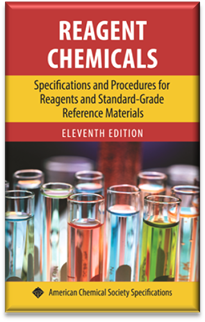OUR COMPANY
Please visit Spex Certiprep for all your certified reference materials and standards
The AAAS STEM volunteer program is looking for retired scientists and engineers to help K-12 science teachers make science more interesting.
Rob Thomas has been a volunteer for the past 9 years. Interested in joining the program?
OUR COMPANY
![]() Scientific
Writing Solutions
Scientific
Writing Solutions
![]()
An Independent Consultant Serving
the Freelance Writing Needs of the Scientific Community
Availability of the New 11th Edition of the ACS Specifications and Procedures for Reagent Chemicals
In June of 2016, the 11th edition of the
American Chemical Society’s book of Reagent
Chemicals will be officially published, which will be the culmination of
7 years work for twenty-five dedicated analytical chemists and their affiliated
organizations who volunteer their time and resources by serving on this ACS
committee. This new compendium will
reflect new methodology, updated procedures and more stringent specifications
with regard to chemical reagents used for analytical testing purposes. An image
of the front cover of the book is shown below.

11th edition of the ACS book of Reagent Chemicals
The process of updating procedures and setting new
specifications is a time-consuming process and can sometimes take years to
complete. By carrying out various testing protocols including sample preparation
and spike recovery procedures, it ensures that new methods are rugged, robust
and will stand up to scrutiny, wherever the book is used around the world. Many
standards organizations and federal agencies that set guidelines, specifications
and/or analytical testing methods—including the United
States Pharmacopeia (USP) and the U.S. Environmental
Protection Agency (EPA) —require the use of ACS grade reagent chemicals in
many of their test procedures. For that reason, it has become the “de facto”
reference book worldwide for the chemicals used in high-purity laboratory
applications.
What is a Reagent
Chemical?
The specifications in this book are intended to serve for reagent chemicals and standard-grade reference materials to be used in precise analytical work of a general nature. The term “reagent-grade chemical” implies that it is a substance of sufficient purity to be used in most chemical analyses or reactions. Standard-grade reference materials are suitable for preparation of analytical standards used for a variety of applications, including instrument calibration, quality control, analyte identification, method performance, and other applications requiring high-purity materials. It is recognized that there may be special uses for reagents and standard-grade reference materials, which may need to conform to more rigorous specifications. Therefore, where necessary, some of the specifications include requirements and tests for certain specialized uses. However, it is impossible to include specifications for all such uses, and thus, there may be occasions when it will be necessary for the analyst to further purify reagents known to have special purity requirements for certain uses.
What's in the
Eleventh Edition
With the publication of the 11th edition, some
of the many highlights include all the additional “supplements” posted
online since the publication of the 10th edition in 2009, removal of
some obsolete test methods, clearer instructions for many of the existing ones,
and also the introduction of many new methods. Overall, the safety, accuracy,
and ease of use in specifications for approximately 70 of the 430 listed
reagents have been improved, and seven new reagents have been added. While there
are numerous minor changes, such as incorporation of the2011 International Union
of Pure and Applied Chemistry (IUPAC), including the recalculation and
redefinition of some atomic weights. In particular, there are several changes
and additions worth noting:
·
The old heavy metal, sulfide precipitation test method is still
valid, but has been replaced with inductively coupled plasma–optical emission
spectroscopy (ICP–OES) for over 50 reagent chemicals.
·
The use of inductively coupled plasma–mass spectroscopy (ICP-MS)
is highly recommended for analyzing many of the ultra-high purity acids and
chemicals.
•
The replacement of atomic absorption (AA) with plasma-based
techniques, as long as method validation is carried out.
•
The replacement of polarography for measuring carbonyl impurities
with gas chromatography–mass spectrometry (GC–MS)
•
New methodologies introduced for the first time include liquid
chromatography– mass spectrometry (LC–MS) and headspace gas chromatography
(HS-GC) analysis.
•
The continuation of green chemistry initiative, which incorporates
fewer toxic chemicals in existing test methodologies.
To order the book, please visit the ACS Reagent Chemicals
Website by clicking on the image of the book below:
OUR SERVICES
You are visitor number:
![]()
Register for Rob's two Short Courses at the Pittsburgh Conference in Orlando and attend his Elemental Impurities in Pharmaceuticals conferee networking session.
OUR SERVICES